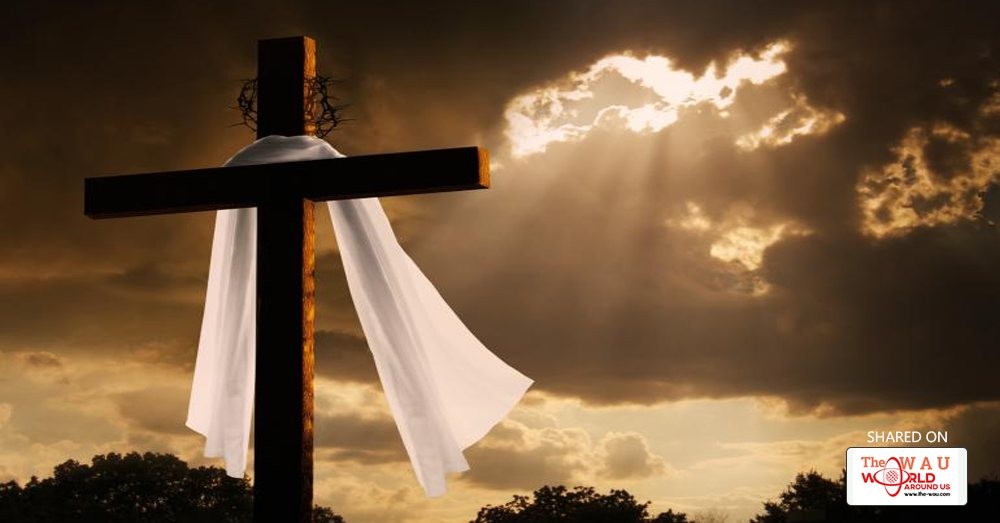Why its called good Friday and we all know as this day as good Friday lets read and find out :
Good Friday is a Christian holiday commemorating the crucifixion of Jesus Christ and his death at Calvary. It is observed during Holy Week as part of the Paschal Triduum on the Friday preceding Easter Sunday, and may coincide with the Jewish observance of Passover. It is also known as Holy Friday, Great Friday, Black Friday, or Easter Friday, though the last term properly refers to the Friday in Easter week.
The date of the holiday on the Gregorian calendar varies from one year to the next, and there is disagreement about its calculation. It is a widely instituted legal holiday around the world, including in most Western countries and 12 U.S. states.
Some countries, such as Germany, have laws prohibiting certain acts, such as dancing and horse racing, that are seen as profaning the solemn nature of the day.
According to the accounts in the Gospels, the Temple Guards, guided by Jesus' disciple Judas Iscariot, arrested Jesus in the Garden of Gethsemane. Judas received money (30 pieces of silver) (Matthew 26:14–16) for betraying Jesus and told the guards that whomever he kisses is the one they are to arrest. Following his arrest, Jesus was taken to the house of Annas, the father-in-law of the high priest, Caiaphas. There he was interrogated with little result and sent bound to Caiaphas the high priest where the Sanhedrin had assembled (John 18:1–24).
Conflicting testimony against Jesus was brought forth by many witnesses, to which Jesus answered nothing. Finally the high priest adjured Jesus to respond under solemn oath, saying "I adjure you, by the Living God, to tell us, are you the Anointed One, the Son of God?" Jesus testified ambiguously, "You have said it, and in time you will see the Son of Man seated at the right hand of the Almighty, coming on the clouds of Heaven." The high priest condemned Jesus for blasphemy, and the Sanhedrin concurred with a sentence of death (Matthew 26:57–66). Peter, waiting in the courtyard, also denied Jesus three times to bystanders while the interrogations were proceeding just as Jesus had predicted.
In the morning, the whole assembly brought Jesus to the Roman governor Pontius Pilate under charges of subverting the nation, opposing taxes to Caesar, and making himself a king (Luke 23:1–2). Pilate authorized the Jewish leaders to judge Jesus according to their own law and execute sentencing; however, the Jewish leaders replied that they were not allowed by the Romans to carry out a sentence of death (John 18:31).
Pilate questioned Jesus and told the assembly that there was no basis for sentencing. Upon learning that Jesus was from Galilee, Pilate referred the case to the ruler of Galilee, King Herod, who was in Jerusalem for the Passover Feast. Herod questioned Jesus but received no answer; Herod sent Jesus back to Pilate. Pilate told the assembly that neither he nor Herod found guilt in Jesus; Pilate resolved to have Jesus whipped and released (Luke 23:3–16). Under the guidance of the chief priests, the crowd asked for Barabbas, who had been imprisoned for committing murder during an insurrection. Pilate asked what they would have him do with Jesus, and they demanded, "Crucify him" (Mark 15:6–14). Pilate's wife had seen Jesus in a dream earlier that day, and she forewarned Pilate to "have nothing to do with this righteous man" (Matthew 27:19). Pilate had Jesus flogged and then brought him out to the crowd to release him. The chief priests informed Pilate of a new charge, demanding Jesus be sentenced to death "because he claimed to be God's son." This possibility filled Pilate with fear, and he brought Jesus back inside the palace and demanded to know from where he came (John 19:1–9).
Antonio Ciseri's depiction of Ecce Homo with Jesus and Pontius Pilate, 19th century
Coming before the crowd one last time, Pilate declared Jesus innocent and washed his own hands in water to show he had no part in this condemnation. Nevertheless, Pilate handed Jesus over to be crucified in order to forestall a riot (Matthew 27:24–26) and ultimately to keep his job. The sentence written was "Jesus of Nazareth, King of the Jews." Jesus carried his cross to the site of execution (assisted by Simon of Cyrene), called the "place of the Skull", or "Golgotha" in Hebrew and in Latin "Calvary". There he was crucified along with two criminals (John 19:17–22).
Jesus agonized on the cross for six hours. During his last three hours on the cross, from noon to 3 pm, darkness fell over the whole land. Jesus spoke from the cross, saying "My God, my God, why have you forsaken me?"
With a loud cry, Jesus gave up his spirit. There was an earthquake, tombs broke open, and the curtain in the Temple was torn from top to bottom. This tear, according to Christian tradition, signified a removal of restriction of the common Jews from the Temple's "Holiest of Holies", and that God's people now could, themselves, communicate directly with their advocate before God, Jesus the Christ, rather than needing the Temple's High Priest as an intercessor. The centurion on guard at the site of crucifixion declared, "Truly this was God's Son!" (Matthew 27:45–54)
Joseph of Arimathea, a member of the Sanhedrin and secret follower of Jesus, who had not consented to his condemnation, went to Pilate to request the body of Jesus (Luke 23:50–52). Another secret follower of Jesus and member of the Sanhedrin named Nicodemus brought about a hundred-pound weight mixture of spices and helped wrap the body of Jesus (John 19:39–40). Pilate asked confirmation from the centurion of whether Jesus was dead (Mark 15:44). A soldier pierced the side of Jesus with a lance causing blood and water to flow out (John 19:34), and the centurion informed Pilate that Jesus was dead (Mark 15:45).
Joseph of Arimathea took Jesus' body, wrapped it in a clean linen shroud, and placed it in his own new tomb that had been carved in the rock (Matthew 27:59–60) in a garden near the site of crucifixion. Nicodemus (John 3:1) also brought 75 pounds of myrrh and aloes, and placed them in the linen with the body, in keeping with Jewish burial customs (John 19:39–40). They rolled a large rock over the entrance of the tomb (Matthew 27:60). Then they returned home and rested, because Shabbat had begun at sunset (Luke 23:54–56). Matt. 28:1 "After the Sabbath, at dawn on the first day of the week, Mary Magdalene and the other Mary went to look at the tomb". i.e. "After the Sabbath, at dawn on the first day of the week,.......". "He is not here; he has risen, just as he said..........".(Matt. 28:6) On the third day, which is now known as Easter Sunday (or Pascha), Jesus rose from the dead.
What’s So Good about Good Friday?
For Christians, Good Friday is a crucial day of the year because it celebrates what we believe to be the most momentous weekend in the history of the world. Ever since Jesus died and was raised, Christians have proclaimed the cross and resurrection of Jesus to be the decisive turning point for all creation. Paul considered it to be “of first importance” that Jesus died for our sins, was buried, and was raised to life on the third day, all in accordance with what God had promised all along in the Scriptures (1 Corinthians 15:3).
On Good Friday we remember the day Jesus willingly suffered and died by crucifixion as the ultimate sacrifice for our sins (1 John 1:10). It is followed by Easter, the glorious celebration of the day Jesus was raised from the dead, heralding his victory over sin and death and pointing ahead to a future resurrection for all who are united to him by faith (Romans 6:5).
Still, why call the day of Jesus’ death “Good Friday” instead of “Bad Friday” or something similar? Some Christian traditions do take this approach: in German, for example, the day is called Karfreitag, or “Sorrowful Friday.” In English, in fact, the origin of the term “Good” is debated: some believe it developed from an older name, “God’s Friday.” Regardless of the origin, the name Good Friday is entirely appropriate because the suffering and death of Jesus, as terrible as it was, marked the dramatic culmination of God’s plan to save his people from their sins.
In order for the good news of the gospel to have meaning for us, we first have to understand the bad news of our condition as sinful people under condemnation. The good news of deliverance only makes sense once we see how we are enslaved. Another way of saying this is that it is important to understand and distinguish between law and gospel in Scripture. We need the law first to show us how hopeless our condition is; then the gospel of Jesus’ grace comes and brings us relief and salvation.
In the same way, Good Friday is “good” because as terrible as that day was, it had to happen for us to receive the joy of Easter. The wrath of God against sin had to be poured out on Jesus, the perfect sacrificial substitute, in order for forgiveness and salvation to be poured out to the nations. Without that awful day of suffering, sorrow, and shed blood at the cross, God could not be both “just and the justifier” of those who trust in Jesus (Romans 3:26). Paradoxically, the day that seemed to be the greatest triumph of evil was actually the deathblow in God’s gloriously good plan to redeem the world from bondage.
The cross is where we see the convergence of great suffering and God’s forgiveness. Psalms 85:10 sings of a day when “righteousness and peace” will “kiss each other.” The cross of Jesus is where that occurred, where God’s demands, his righteousness, coincided with his mercy. We receive divine forgiveness, mercy, and peace because Jesus willingly took our divine punishment, the result of God’s righteousness against sin. “For the joy set before him” (Hebrews 12:2) Jesus endured the cross on Good Friday, knowing it led to his resurrection, our salvation, and the beginning of God’s reign of righteousness and peace.
Good Friday marks the day when wrath and mercy met at the cross. That’s why Good Friday is so dark and so Good..
Share This Post















